Difference between revisions of "Leather"
m |
|||
| Line 27: | Line 27: | ||
| − | == | + | ==What does leather consist of?== |
Leather consists of collagen fibres (protein). These fibres are intertwined. Each collagen fibre consists of up to 2 million fibrils. The density of intertwining varies from [[Types of leather|species to species]]. But even [[Parts of the hide|within an animal skin]], the density of intertwining differs significantly. A looser [[Loose grain leather|fibre structure]] is [[Leather quality|less resistant]] to tearing than a dense structure. | Leather consists of collagen fibres (protein). These fibres are intertwined. Each collagen fibre consists of up to 2 million fibrils. The density of intertwining varies from [[Types of leather|species to species]]. But even [[Parts of the hide|within an animal skin]], the density of intertwining differs significantly. A looser [[Loose grain leather|fibre structure]] is [[Leather quality|less resistant]] to tearing than a dense structure. | ||
| Line 44: | Line 44: | ||
[[Tanning leather|Tanned]] leather consists depending on [[Types of leather|type of leather]], [[Tanning leather|type of tanning]] and type of [[Leather dye - Leather color - Leather colour|colouration]] of 45 to 75% hide substance, 8 to 45% [[Tannins|tannins]], 1 to 25% oils and / or fats, up to 3% [[Leather dye - Leather color - Leather colour|dye]] and [[Leather dye - Leather color - Leather colour|pigment colour]] and 8 to 15% moisture. The tannins prevent the decay of the hide substance and oils, fats and moisture make the leather supple. | [[Tanning leather|Tanned]] leather consists depending on [[Types of leather|type of leather]], [[Tanning leather|type of tanning]] and type of [[Leather dye - Leather color - Leather colour|colouration]] of 45 to 75% hide substance, 8 to 45% [[Tannins|tannins]], 1 to 25% oils and / or fats, up to 3% [[Leather dye - Leather color - Leather colour|dye]] and [[Leather dye - Leather color - Leather colour|pigment colour]] and 8 to 15% moisture. The tannins prevent the decay of the hide substance and oils, fats and moisture make the leather supple. | ||
| − | The most common kind of [[Tanning leather|tanning]] is [[Chrome tanned|chrome tanning]]. [[Leather clothing|Leather clothing]] and [[Leather shoes|leather shoes]] are almost exclusively chrome tanned nowadays. | + | The most common kind of [[Tanning leather|tanning]] is [[Chrome tanned|chrome tanning]]. [[Leather clothing|Leather clothing]] and [[Leather shoes|leather shoes]] are almost exclusively chrome tanned nowadays. [[Chrome tanned|chrome III]] is harmless and occurs in many food sources. Today's leather goods are well controlled and except rare exceptions free of toxins. |
| Line 50: | Line 50: | ||
Leather is a noble and natural material, which is mainly for processed [[Leather shoes|shoes]], [[Leather furniture|furniture]], [[Car leather|car interiors]], [[Leather clothing|clothing]] and [[Leather handbags|leather bags]]. About 500,000 tons of leather are [[leather industry|produced]] each year, which is about 1.5 billion [[Measures and weights|square meters]]. | Leather is a noble and natural material, which is mainly for processed [[Leather shoes|shoes]], [[Leather furniture|furniture]], [[Car leather|car interiors]], [[Leather clothing|clothing]] and [[Leather handbags|leather bags]]. About 500,000 tons of leather are [[leather industry|produced]] each year, which is about 1.5 billion [[Measures and weights|square meters]]. | ||
| − | Leather is a natural product, durable and warm. Leather also has a technical advantage over alternative materials. One gram of leather has up to 300 m² interior surface, because its fine fibres are tightly intertwined. As a result, leather has a high [[Leather quality|resistance]] to tearing, stretching and bending. Leather is resistant to aging and temperature resistant. Leather can absorb up to 30% water, without being "wet". Leather can absorb moisture inside, and return it to the outside. Leather has an insulating effect. | + | Leather is a natural product, durable and warm. Leather also has a technical advantage over alternative materials. One gram of leather has up to 300 m² interior surface, because its fine fibres are tightly intertwined. As a result, leather has a high [[Leather quality|resistance]] to tearing, stretching and bending. Leather is resistant to aging and temperature resistant. Leather can absorb up to 30% water, without being "wet". Leather can absorb moisture inside, and return it to the outside. Leather has an insulating effect. Imitation leather or any other substitute do not come close in displaying similar properties. In particular for shoes and leather clothing, leather is a clear advantage and offers unrivalled comfort with high durability. Another advantage of leather is its [[Flammability and fire retardancy of leather|low flammability]]. |
| − | Leather | + | Leather is incredibly diverse. It can be produced from different [[Exotic leather|animal species]]. There are many different [[Types of leather|types of leather]]. [[Suede]], [[Nubuck|nubuck]], [[Buckskin|buckskin]], [[Aniline leather|aniline]], [[Semi-aniline|semi-aniline]], [[Pigmented leather|pigmented leather]], [[Full grain leather|full grain]], [[Corrected grain|corrected grain]], [[PU leather|bycast]], [[Pull up leather - Greased leather - Waxed leather - Oiled leather|greased leather, waxed leather, oiled leather]], [[Fur|fur]] and a lot more. The [[Leather grain texture|grain pattern]] of leather can be [[Embossed leather|enhanced]] or [[Ironing leather|flattened]]. It can also be [[Carving leather|carved]] with individual motifs or it can be [[Embossed leather|embossed]] entirely. [[Haptic evaluation of leather surfaces|Buttery soft]] garment leather can be produced as well as hard and stiff [[Leather shoes|leather soles]] and [[Leather belt|leather belts]]. Leather can be [[Formed leather|formed]] or [[Perforated leather|perforated]]. |
| Line 67: | Line 67: | ||
Leather can be manufactured and processed in a wide [[Types of leather|spectrum of varieties]]. Leather is mixed with other materials and frequently the question arises, if [[Genuine leather|the description "Leather" or "Genuine Leather"]] is used conforming to the norms and laws. All countries have different standards and laws. Sometimes there are different rules for different uses of leather within a country. In Germany, for example, in [[Leather furniture|upholstered furniture]] [[Split leather|split leather]] must be specified in the description. To only declare "Leather" is not allowed. This rule does not apply to [[Car leather|automotive leather]]. Many manufacturers of high-priced vehicles in Germany process [[Split leather|split leather]] in car interiors without specifying it in the material description. In countries like France the rules are much stricter. | Leather can be manufactured and processed in a wide [[Types of leather|spectrum of varieties]]. Leather is mixed with other materials and frequently the question arises, if [[Genuine leather|the description "Leather" or "Genuine Leather"]] is used conforming to the norms and laws. All countries have different standards and laws. Sometimes there are different rules for different uses of leather within a country. In Germany, for example, in [[Leather furniture|upholstered furniture]] [[Split leather|split leather]] must be specified in the description. To only declare "Leather" is not allowed. This rule does not apply to [[Car leather|automotive leather]]. Many manufacturers of high-priced vehicles in Germany process [[Split leather|split leather]] in car interiors without specifying it in the material description. In countries like France the rules are much stricter. | ||
| − | As the rules are different from country to country, this dictionary only can help to ask the right questions and to teach how to distinguish [[Leather quality|leather qualities]]. There are many varieties of good and bad leather. But | + | As the rules are different from country to country, this dictionary only can help to ask the right questions and to teach how to distinguish [[Leather quality|leather qualities]]. There are many varieties of good and bad leather. But anyone buying "[[Genuine leather|genuine Leather]]", should always check, if the material is correctly described and if the [[Leather quality|leather quality]] is acceptable for the specified price prior to purchasing. |
| − | In particular, in online business or discounted offers "leather" is frequently incorrect declared. It | + | In particular, in online business or discounted offers "leather" is frequently incorrect declared. It is difficult for the customers to find out, if it's really "[[Genuine leather|Genuine Leather]]". |
Different countries have different norms, standards, regulations and terms to define leather and [[Types of leather|leather types]]. These are not laws. But norms and regulations help in case of disagreements and are cited by experts in legal disputes. | Different countries have different norms, standards, regulations and terms to define leather and [[Types of leather|leather types]]. These are not laws. But norms and regulations help in case of disagreements and are cited by experts in legal disputes. | ||
| Line 89: | Line 89: | ||
===Basic requirements for the term [[Genuine leather|Leather]]=== | ===Basic requirements for the term [[Genuine leather|Leather]]=== | ||
| − | As each country has different declaration rules, | + | As each country has different declaration rules, we believe some basics which should be taken into account in all countries to assure that the use of the word "leather" is not meaningless. |
| − | + | IDifferent languages and countries have different terms used to describe leather and types of leather. Rules & laws should govern the use of terms and should make sure that such terms can only be used if really "leather" is meant. In English language declarations like "[[Aniline leather|Aniline]]", "[[Nubuck]]", "[[Suede]]", "[[Napa leather|Napa]]", "[[Genuine leather|Genuine Leather]]", "[[Cow hide|Cow Hide]]", "[[Sheepskin - Lambskin|Sheepskin]]", "[[Leather jacket|Leather Jacket]]", "[[Leather wallets|Leather wallet]]" etc. should describe the material "leather" as defined in the norms and regulations. | |
If an offered product is not leather, this information must be easy to find and clearly explained to the consumer. Lowercase notes on the backside and/or flowery declarations are not enough. The material declaration must be easy to understand to all and easy to find. | If an offered product is not leather, this information must be easy to find and clearly explained to the consumer. Lowercase notes on the backside and/or flowery declarations are not enough. The material declaration must be easy to understand to all and easy to find. | ||
| Line 97: | Line 97: | ||
If materials which only look like leather are offered, descriptions or names which might let the customer believe it is genuine leather, should not allowed. An exception in a lot of countries are the words describing imitation leather. If in a country the consumers know that words like "Faux Leather", "Imitation Leather", "Synthetic Leather" or "Artificial Leather" are not describing leather, these designations should be allowed to be used. | If materials which only look like leather are offered, descriptions or names which might let the customer believe it is genuine leather, should not allowed. An exception in a lot of countries are the words describing imitation leather. If in a country the consumers know that words like "Faux Leather", "Imitation Leather", "Synthetic Leather" or "Artificial Leather" are not describing leather, these designations should be allowed to be used. | ||
| − | Confusing names inventions like "Koskin", "Textile-Leather", "Regenerated Leather" etc. must be forbidden to be used. These names have been already used in the past for materials which were not leather. Most customers thought | + | Confusing names inventions like "Koskin", "Textile-Leather", "Regenerated Leather" etc. must be forbidden to be used. These names have been already used in the past for materials which were not leather. Most customers thought they were buying [[Genuine leather|Genuine Leather]]. |
| − | Depending on the country | + | Depending on the country, the local language and tradition descriptions like "Faux Leather", "Faux Fur" might also be confusing for the consumer. Often such descriptions are in English, even if the national language is not. |
| − | Descriptions like "Leather Look" and "leather-like" should be understandable, but also depends on the | + | Descriptions like "Leather Look" and "leather-like" should be understandable, but also depends on the local language and the way how consumers interpret such descriptions. |
Clear explanations should be allowed and cheating of the customers should be forbidden. | Clear explanations should be allowed and cheating of the customers should be forbidden. | ||
| Line 121: | Line 121: | ||
===The [[Measures and weights|layer thickness]] and the ratio of different layers=== | ===The [[Measures and weights|layer thickness]] and the ratio of different layers=== | ||
| − | In a lot of countries leather, which have a surface coating or surface layer | + | In a lot of countries, leather, which have a surface coating or surface layer thicker than 0,15 mm, have to be declared as "[[Coated leather - Laminated leather|Coated Leather]]" irrespective of the way the coating was applied.. If the coating or surface layer exceeds one third of the total thickness of the product, it's not even allowed to call it "Coated Leather". In such cases it`s not leather any more. This is also of importance, when thin layers of leather are glued on other materials. |
* > 0,15 mm surface coating or leather: "[[Coated leather - Laminated leather|Coated Leather]]" | * > 0,15 mm surface coating or leather: "[[Coated leather - Laminated leather|Coated Leather]]" | ||
| − | * > 0,15 mm surface coating or leather and layer | + | * > 0,15 mm surface coating or leather and layer exceeds one third of the total [[Measures and weights|thickness]]: Is not allowed to be called "Leather". |
* Composite materials ([[Leather watch strap|leather watch straps]], [[Leather belt|leather belts]], [[Leather mobile phone case|Leather mobile phone cases]] etc.) with less than 80% leather of the total [[Measures and weights|thickness]] must be clearly declared to the consumer (e.g. outside leather, inside textile). | * Composite materials ([[Leather watch strap|leather watch straps]], [[Leather belt|leather belts]], [[Leather mobile phone case|Leather mobile phone cases]] etc.) with less than 80% leather of the total [[Measures and weights|thickness]] must be clearly declared to the consumer (e.g. outside leather, inside textile). | ||
| Line 133: | Line 133: | ||
A [[Car leather|leather interior]] of a car must be processed on the major surfaces of leather. | A [[Car leather|leather interior]] of a car must be processed on the major surfaces of leather. | ||
| − | + | If the leather is permanently connected with another material (for example glued on a textile base), it can only be classed as a leather item, if leather represents 80% of the total [[Measures and weights|thickness]]. Otherwise, external and internal materials must be declared separately. | |
| Line 142: | Line 142: | ||
===[[Split leather]]=== | ===[[Split leather]]=== | ||
| − | The declaration of [[Split leather|split leather]] is different | + | The declaration of [[Split leather|split leather]] is different in almost every country and in most cases with a lot of contradictions. In Germany RAL 060 A2 allows to declare split leather as [[Genuine leather|genuine leather]]. DIN EN 15987 only allows the term "split leather". "Leather" alone is not sufficient. |
It is beyond dispute that [[Split leather|split leather]] is not of same [[Leather quality|quality]] as [[Top grain leather|grain side split]]. Sometimes the [[Split leather|flesh side split]] is coated with a finish and embossed or a [[PU leather|layer of embossed and coloured polyurethane]] is glued to the surface to let it look like the more valuable [[Top grain leather|grain side split]]. The end consumer cannot identify the quality. The leather is then like a low-grade wood veneered with exotic wood. The upper side is coated [[Suede|suede]] and the [[Leather grain texture|grain texture]] is created by [[Embossed leather|embossing]]. | It is beyond dispute that [[Split leather|split leather]] is not of same [[Leather quality|quality]] as [[Top grain leather|grain side split]]. Sometimes the [[Split leather|flesh side split]] is coated with a finish and embossed or a [[PU leather|layer of embossed and coloured polyurethane]] is glued to the surface to let it look like the more valuable [[Top grain leather|grain side split]]. The end consumer cannot identify the quality. The leather is then like a low-grade wood veneered with exotic wood. The upper side is coated [[Suede|suede]] and the [[Leather grain texture|grain texture]] is created by [[Embossed leather|embossing]]. | ||
| Line 150: | Line 150: | ||
Also the [[Car leather|car manufacturers]] up to the higher price ranges are increasingly using coated split leather for the unloaded areas (door panels, headrests, [[Leather steering wheel|steering wheels]]) without a clarifying declaration. The consumer will then acquire good faith a quality [[Full leather trim|full leather trim]] with high extra costs and receives partially coated split leather. Consumers who want to make sure, that they don't pay for split leather, should ask and let confirm this in the purchase contract. | Also the [[Car leather|car manufacturers]] up to the higher price ranges are increasingly using coated split leather for the unloaded areas (door panels, headrests, [[Leather steering wheel|steering wheels]]) without a clarifying declaration. The consumer will then acquire good faith a quality [[Full leather trim|full leather trim]] with high extra costs and receives partially coated split leather. Consumers who want to make sure, that they don't pay for split leather, should ask and let confirm this in the purchase contract. | ||
| − | It would be much better for the consumers, if all producers would be forced to declare clearly when split leather is used. The consumer cannot distinguish between the two different qualities and it would create transparency | + | It would be much better for the consumers, if all producers would be forced to declare clearly when split leather is used. The consumer cannot distinguish between the two different qualities and it would create transparency allowing the consumer to decide, whether the price for the offered material is appropriate. It would also stop the industry to offer more and more split leather in unexpected areas. There is a loophole that should be closed in many countries. In the long run it will help the reputation of leather both as a material and also as an industry, when customers are clearly informed and do not need to be suspicious. |
| Line 186: | Line 186: | ||
===[[Patent leather]]=== | ===[[Patent leather]]=== | ||
| − | [[Patent leather]] can be declared with this term, even if the surface layer is thicker than 0,15 mm. It | + | [[Patent leather]] can be declared with this term, even if the surface layer is thicker than 0,15 mm. It cannot be declared as "[[Coated leather - Laminated leather|Coated Leather]]". This exception is understandable, because consumers evaluate the product correctly. In patent leather, it is generally known that a thicker layer is applied. |
Revision as of 20:29, 2 November 2016
Contents
- 1 History
- 2 What does leather consist of?
- 3 Why leather?
- 4 What materials can be called leather?
- 4.1 Basic requirements for the term Leather
- 4.2 The fibre structure
- 4.3 The layer thickness and the ratio of different layers
- 4.4 The proportion to other materials
- 4.5 Split leather
- 4.6 Artificial leather with leather fibres on the backside
- 4.7 Patent leather
- 4.8 The labelling requirement for shoes
- 4.9 The marking of leather and fur by leather symbols or texts
- 5 Additional information
- 6 Leather videos
History
Leather accompanied mankind since the beginning. At the beginning of human history furs and hides of captured animals gave protection from cold and humidity in form of blankets, leather clothing, shoes or boots. Leather also was used as tent walls, kayak boat walls, thongs, belts or leather vessels. Because of the ability to use leather, it was possible to survive even in the coldest regions of our planet and to generally make the life more comfortable.
Nowadays, most leather is made of animals we use as food. Cow leather, sheep leather, goatskin or pig leather are the most common species people eat.
The tanning process prevents the decay of animal skin. Tanning is probably an accidental discovery. Initially, animal skins were fleshed, dried and rubbed with grease and oil to preserve them, too keep them softer and to make them water resistant.
At some point someone must have discovered, that animal skin, which was longer time in water with plant residues, absorbed dissolved tannins from the plant residues and converted the skin to resistant leather. From this, tanners developed a sophisticated tanning process which made a long-lasting and durable end product from hides and skins.
At the end of the 19th century the chrome tanning was discovered. This new tanning process shortened the production time enormously and was the start of the industrialization of leather production.
Today tanners offer endless types of leather with different leather surfaces and colours.
What does leather consist of?
Leather consists of collagen fibres (protein). These fibres are intertwined. Each collagen fibre consists of up to 2 million fibrils. The density of intertwining varies from species to species. But even within an animal skin, the density of intertwining differs significantly. A looser fibre structure is less resistant to tearing than a dense structure.
Leather in oblique section and cross section. At the top, the fibre intertwining is denser and more stable.
Tanned leather consists depending on type of leather, type of tanning and type of colouration of 45 to 75% hide substance, 8 to 45% tannins, 1 to 25% oils and / or fats, up to 3% dye and pigment colour and 8 to 15% moisture. The tannins prevent the decay of the hide substance and oils, fats and moisture make the leather supple.
The most common kind of tanning is chrome tanning. Leather clothing and leather shoes are almost exclusively chrome tanned nowadays. chrome III is harmless and occurs in many food sources. Today's leather goods are well controlled and except rare exceptions free of toxins.
Why leather?
Leather is a noble and natural material, which is mainly for processed shoes, furniture, car interiors, clothing and leather bags. About 500,000 tons of leather are produced each year, which is about 1.5 billion square meters.
Leather is a natural product, durable and warm. Leather also has a technical advantage over alternative materials. One gram of leather has up to 300 m² interior surface, because its fine fibres are tightly intertwined. As a result, leather has a high resistance to tearing, stretching and bending. Leather is resistant to aging and temperature resistant. Leather can absorb up to 30% water, without being "wet". Leather can absorb moisture inside, and return it to the outside. Leather has an insulating effect. Imitation leather or any other substitute do not come close in displaying similar properties. In particular for shoes and leather clothing, leather is a clear advantage and offers unrivalled comfort with high durability. Another advantage of leather is its low flammability.
Leather is incredibly diverse. It can be produced from different animal species. There are many different types of leather. Suede, nubuck, buckskin, aniline, semi-aniline, pigmented leather, full grain, corrected grain, bycast, greased leather, waxed leather, oiled leather, fur and a lot more. The grain pattern of leather can be enhanced or flattened. It can also be carved with individual motifs or it can be embossed entirely. Buttery soft garment leather can be produced as well as hard and stiff leather soles and leather belts. Leather can be formed or perforated.
What materials can be called leather?
Leather can be manufactured and processed in a wide spectrum of varieties. Leather is mixed with other materials and frequently the question arises, if the description "Leather" or "Genuine Leather" is used conforming to the norms and laws. All countries have different standards and laws. Sometimes there are different rules for different uses of leather within a country. In Germany, for example, in upholstered furniture split leather must be specified in the description. To only declare "Leather" is not allowed. This rule does not apply to automotive leather. Many manufacturers of high-priced vehicles in Germany process split leather in car interiors without specifying it in the material description. In countries like France the rules are much stricter.
As the rules are different from country to country, this dictionary only can help to ask the right questions and to teach how to distinguish leather qualities. There are many varieties of good and bad leather. But anyone buying "genuine Leather", should always check, if the material is correctly described and if the leather quality is acceptable for the specified price prior to purchasing.
In particular, in online business or discounted offers "leather" is frequently incorrect declared. It is difficult for the customers to find out, if it's really "Genuine Leather".
Different countries have different norms, standards, regulations and terms to define leather and leather types. These are not laws. But norms and regulations help in case of disagreements and are cited by experts in legal disputes.
In Germany, for example, the following standards are of importance:
- RAL 060 A2: Defines the term "leather" and the differentiation from other materials.
- DIN EN 15987 (European standard): Leather - Terminology - Key definitions for the leather trade.
- DIN 68871: Defines the terms for leather for the furniture upholstery.
- DIN EN 16223 (European standard): Leather - Requirements for the designation and description of leather in upholstery and automotive interior applications.
Symbol Genuine Leather.
Basic requirements for the term Leather
As each country has different declaration rules, we believe some basics which should be taken into account in all countries to assure that the use of the word "leather" is not meaningless.
IDifferent languages and countries have different terms used to describe leather and types of leather. Rules & laws should govern the use of terms and should make sure that such terms can only be used if really "leather" is meant. In English language declarations like "Aniline", "Nubuck", "Suede", "Napa", "Genuine Leather", "Cow Hide", "Sheepskin", "Leather Jacket", "Leather wallet" etc. should describe the material "leather" as defined in the norms and regulations.
If an offered product is not leather, this information must be easy to find and clearly explained to the consumer. Lowercase notes on the backside and/or flowery declarations are not enough. The material declaration must be easy to understand to all and easy to find.
If materials which only look like leather are offered, descriptions or names which might let the customer believe it is genuine leather, should not allowed. An exception in a lot of countries are the words describing imitation leather. If in a country the consumers know that words like "Faux Leather", "Imitation Leather", "Synthetic Leather" or "Artificial Leather" are not describing leather, these designations should be allowed to be used.
Confusing names inventions like "Koskin", "Textile-Leather", "Regenerated Leather" etc. must be forbidden to be used. These names have been already used in the past for materials which were not leather. Most customers thought they were buying Genuine Leather.
Depending on the country, the local language and tradition descriptions like "Faux Leather", "Faux Fur" might also be confusing for the consumer. Often such descriptions are in English, even if the national language is not.
Descriptions like "Leather Look" and "leather-like" should be understandable, but also depends on the local language and the way how consumers interpret such descriptions.
Clear explanations should be allowed and cheating of the customers should be forbidden.
Declarations like "Leather-Look" plus "Textile Leather" are not allowed in Germany. Especially the use of "Textile Leather" is forbidden.
The fibre structure
The word "Leather" should only be allowed to be used, if splitted or unsplitted tanned skin of animals with its more or less intact original fibrous structure is described.
Materials which are produced of milled ore shredded leather heave to be clearly declared. A typical term for such material is bonded leather. This term misleads consumers as it is not well known to all and the percentage of leather fibres is not clearly indicated. It is discussed, if the use of the term "Bonded Leather" should only be allowed if the content of leather fibres is minimum 50% and to only allow clear descriptions like "Bonded Leather containing 60% leather fibres and 40% non-leather substances".
The layer thickness and the ratio of different layers
In a lot of countries, leather, which have a surface coating or surface layer thicker than 0,15 mm, have to be declared as "Coated Leather" irrespective of the way the coating was applied.. If the coating or surface layer exceeds one third of the total thickness of the product, it's not even allowed to call it "Coated Leather". In such cases it`s not leather any more. This is also of importance, when thin layers of leather are glued on other materials.
- > 0,15 mm surface coating or leather: "Coated Leather"
- > 0,15 mm surface coating or leather and layer exceeds one third of the total thickness: Is not allowed to be called "Leather".
- Composite materials (leather watch straps, leather belts, Leather mobile phone cases etc.) with less than 80% leather of the total thickness must be clearly declared to the consumer (e.g. outside leather, inside textile).
The proportion to other materials
The surfaces of leather objects which is relevant to the use must consist predominantly of genuine leather, or may otherwise not be named so. That is the case, if the product is mainly made of synthetic leather. Basically the relevant materials have to be declared unequivocally (for example "artificial leather bag with leather decoration").
A leather interior of a car must be processed on the major surfaces of leather.
If the leather is permanently connected with another material (for example glued on a textile base), it can only be classed as a leather item, if leather represents 80% of the total thickness. Otherwise, external and internal materials must be declared separately.
Split leather
The declaration of split leather is different in almost every country and in most cases with a lot of contradictions. In Germany RAL 060 A2 allows to declare split leather as genuine leather. DIN EN 15987 only allows the term "split leather". "Leather" alone is not sufficient.
It is beyond dispute that split leather is not of same quality as grain side split. Sometimes the flesh side split is coated with a finish and embossed or a layer of embossed and coloured polyurethane is glued to the surface to let it look like the more valuable grain side split. The end consumer cannot identify the quality. The leather is then like a low-grade wood veneered with exotic wood. The upper side is coated suede and the grain texture is created by embossing.
Inexpensive furniture is often manufactured with coated split leather or imitation leather on outside surfaces and the contact areas (backs, seats, armrests and armrest insides) are processed with grain leather. In some countries, split leather is even not allowed on contact surfaces (Germany RAL-GZ 430/4). If the outside surfaces are not of grain leather, the declaration could be for example "Leather sofa - back and sides split leather". Unfortunately, the buyers of furniture are very often not properly informed. Therefore, one should always ask when buying furniture of what materials it really is. Unfortunately, the declarations especially when buying online are very often wrong. Therefore, always let confirm the material description in the invoice!
Also the car manufacturers up to the higher price ranges are increasingly using coated split leather for the unloaded areas (door panels, headrests, steering wheels) without a clarifying declaration. The consumer will then acquire good faith a quality full leather trim with high extra costs and receives partially coated split leather. Consumers who want to make sure, that they don't pay for split leather, should ask and let confirm this in the purchase contract.
It would be much better for the consumers, if all producers would be forced to declare clearly when split leather is used. The consumer cannot distinguish between the two different qualities and it would create transparency allowing the consumer to decide, whether the price for the offered material is appropriate. It would also stop the industry to offer more and more split leather in unexpected areas. There is a loophole that should be closed in many countries. In the long run it will help the reputation of leather both as a material and also as an industry, when customers are clearly informed and do not need to be suspicious.
film coating with split leather - film coating with PU leather.
Video about the production of split leather and PU leather
Artificial leather with leather fibres on the backside
Some producers of furniture offer an artificial leather with leather fibres glued to the backside. In advertising, these materials are then offered as "leather-like" with lots of arguments. But this material has no benefits of leather and is not allowed to be sold as "leather". It`s just a marketing trick.
An extreme example of false declaration. Imitation leather with leather fibres glued to the backside, but at first glance it looks like real leather.
Patent leather
Patent leather can be declared with this term, even if the surface layer is thicker than 0,15 mm. It cannot be declared as "Coated Leather". This exception is understandable, because consumers evaluate the product correctly. In patent leather, it is generally known that a thicker layer is applied.
The labelling requirement for shoes
In Europe there is a material labelling requirement for shoes. But that applies only to shoes and for no other leather goods. It would be desirable for the protection of the consumer if this would also apply to other leather products.
The marking of leather and fur by leather symbols or texts
Some clients seek genuine leather or genuine fur and others refuse all kind of animal materials. As customer information, there are different symbols and texts in order to characterize the offered material. Refer to the information about "genuine leather" .
Additional information
- Artificial leather with leather fibres on the backside
- The material examination of leather mobile phone case
- The material examination of leather belts
Leather videos













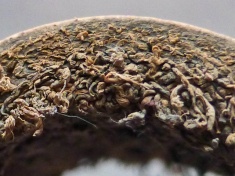
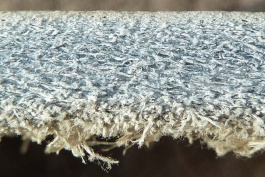





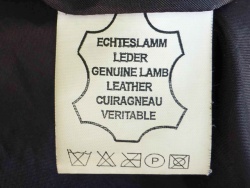
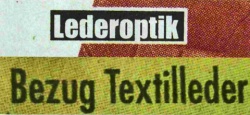
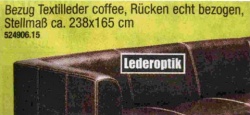

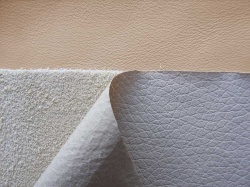
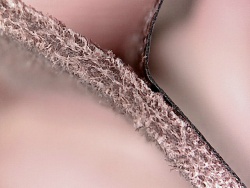
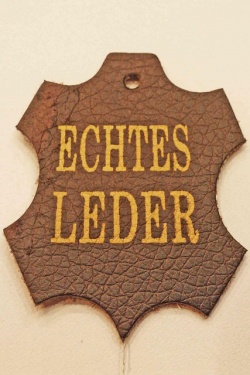
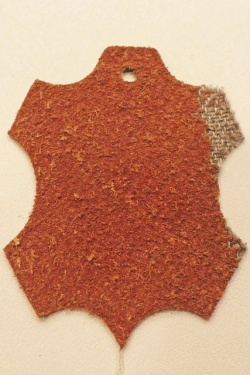
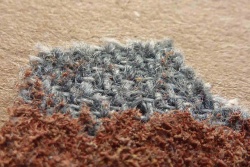
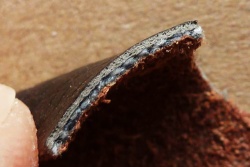





 a kotori web solution
a kotori web solution